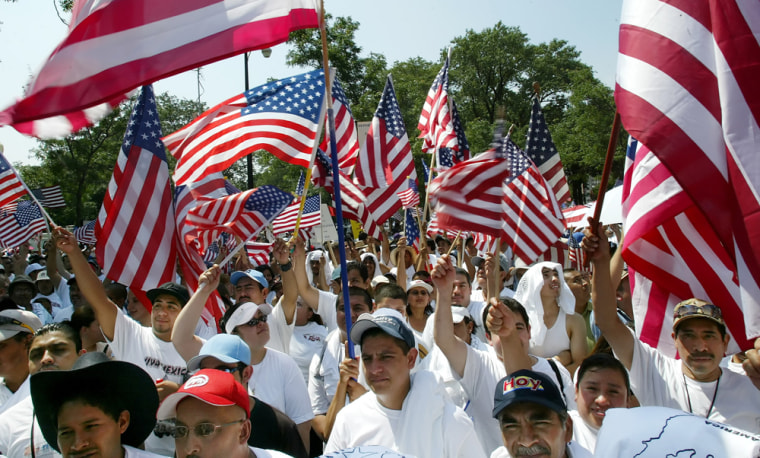BURBANK — Immigration was a major hot-button issue in the U.S. in 2006. From the push for a bill that would have made it a felony to be in this country illegally to the major push-back that resulted in widespread demonstrations across the country, the immigration debate was contentious.
Once the Democrats take power in Congress in January, will they take on the hot button issue again?
The year that was: 2006
The push for an immigration bill
In the spring of 2006, President Bush called for a “balanced” approach to the issue of immigration: tougher enforcement at the border coupled with programs to permit legal “guest workers” in this country and a path to legalization, with restrictions, for illegal immigrants who are longtime U.S. residents.
But Republicans in congress favored a more punitive approach to illegal immigration, calling the presence of an estimated 12 million illegal immigrants in this country a threat to homeland security. The House version of the immigration bill would have made it a felony to be in this country illegally.
Huge immigration rights demonstrations
Angered by the direction Congress appeared to be taking, hundreds of thousands of Latino immigration-rights protestors took to the streets of major metropolitan areas, arguing that illegal immigrants should not be treated as criminals.
On April 10, they marched in 102 different U.S. cities. It was mostly an ad-hoc effort, organized by church and labor groups and publicized by Spanish-language radio personalities. Conservative critics were offended by the fact that many of the demonstrators carried huge Mexican flags.
Bush sends National Guard to border
On May 15, Bush announced he was sending thousands of National Guard troops to the Mexican border to assist the U.S. Border Patrol. President Vicente Fox of Mexico denounced the move, calling it an unwarranted “militarization of the border,” although the White House stressed that the troops would not be directly involved in police work.
Border wall legislation signed
In October, after Congress refused to pass comprehensive immigration reform, Bush signed a bill that would construct 700 miles of reinforced fencing and walls along the Mexican border. Mexico denounced it as a U.S. version of the Berlin Wall. The bill did not include funding for the construction. The president maintained his call for a guest worker program as a legal alternative for undocumented workers.
Latinos vote for Democrats in November election
In the November mid-term election, Latino voters favored Democrats over Republicans by a margin of 69 percent to 30 percent, a big slip for the GOP from the 2004 election.
While immigration was one reason Latinos voted for Democrats, experts disagree on how important the issue was, citing Latino concerns about the economy and the war in Iraq as other factors influencing their vote.
What to watch out for in 2007
A new Congress responds to immigration issues
Now that Democrats run Congress, they may be more willing to go along with Bush’s call for a guest worker program than Republican conservatives were. However, it’s doubtful that the new congress will fully fund the border wall. Democrats will have to balance the concerns of Latino constituents with the rising public outcry over illegal immigration.
The Latino Vote — Part II:
As the candidates and parties gear up for the 2008 presidential race, the Latino vote will be very much on their minds. Pollster Jim Zogby estimates that a heavy voter registration drive could produce an electorate that’s 10 percent Latino.
As Democrats dance around the immigration issue, Republicans will have to work hard to counteract charges that they’re anti-immigrant. The spotlight will be on key competitive states such as Florida, Arizona, Colorado and New Mexico, where Latinos represent a significant percentage of the population.
Smart borders — how much?
There’s been a lot of talk about how high-tech devices, sensors and video cameras can assist the U.S. Border patrol in securing the thousands of miles of border with Mexico and Canada. In the 2007 Homeland Security bill, Congress appropriated $1.2 billion to construct physical and electronic barriers at the border.
Some watchdog groups complain that this technology could wind up costing many more billions of dollars without putting a significant dent in illegal immigration. Look for a flurry of stories in 2007 about potential cost overruns for devices that don’t work as well as promised.
A new president in Mexico
Mexico’s new President, Felipe Calderon, got off to a rocky start, winning by a razor-thin margin in an election that was protested by his leftist opponent. The big question for Calderon in 2007 is whether he can do much to improve Mexico’s economy and create more jobs south of the border, factors that would help stem the flow of illegal immigrants to the United States.
Cities, states go after illegal immigrants
Responding to public concern about illegal immigrants, cities and states are enacting measures to punish them. In Texas, as the state legislature gets ready for the 2007 session, lawmakers have filed a mound of bills that would deny welfare to the children of illegal immigrants and levy taxes on money transfers to Mexico. Look for other states and cities to follow suit with similar punitive measures.
